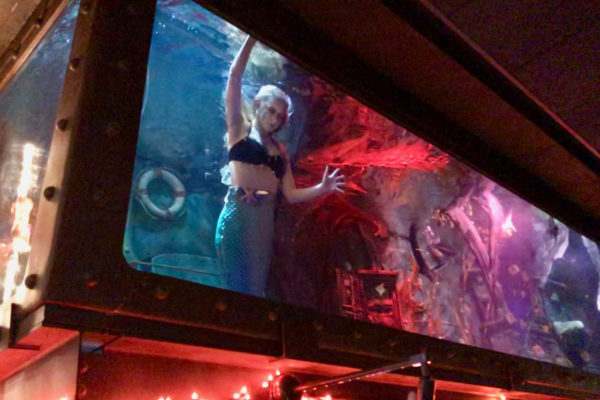
It’s perhaps an apt metaphor that one of our favorite stops during the recent HighEdWeb Conference in Sacramento (aka #heweb18) was the nightly mermaid shows at a place called Dive Bar. Because, in a way, higher ed communicators find themselves in the mermaid’s dilemma.
The folk tale that also served as the basis for the Disney blockbuster “The Little Mermaid” features the mermaid Ariel falling in love with a human, but facing a difficult decision: If she remains true to who she is, as a sea-dwelling mermaid, she has no future with the man she loves. If she could adapt human form, she could never go back to her mermaid lifestyle.
We feel like that in the higher ed digital community sometimes. We try to stay true to ourselves and what we know our best practices, but something we find ourselves trying to please others in ways that go against our own core values.
We can gain enough expertise to speak at a conference full of brilliant humans, only to be treated like paupers on our own campuses. Through education, training, sharing ideas, innovation and trial and error, we gain expertise that allows us to generate success for our institutions and our audiences. But then HiPPOs and various others with no knowledge of these acquired best practices dismiss our expertise and make requests we know are not good for our institutions: Post this flyer on social media, put this dense mission statement prominently on the website, write this story that we’ve said no to others in the past and now will have to write 10 more in the future.
But the thing about the mermaid’s dilemma, and folks tails in general, is that it assumes a false dichotomy: We can either be this thing or that thing. We make the same mistake in higher ed: We can either do things our way or their way. But that’s overly simplistic. Generally fairy tales work themselves out with some kind of deux ex machina or some kind of magic. nd you know what: We work in positions where we can make magic happen.
As it turns out, closing keynote Sir Ken Robinson gave us the keys for getting past our mermaid’s dilemma. He spoke of the three Cs that aren’t used enough in educating children but which can better prepare them for the future: curiosity, creativity and collaboration.
Curiosity: Yes, we think we have the answers, but have we, in fact, asked the questions? One facet of curiosity is that we need to get outside ourselves (or get over ourselves) and learn more about what those asking things of us truly want. Another facet of curiosity is always looking for a better way and trying new things to move our institutions — and the industry — forward.
Creativity: This is where the magic happens. Whether it’s in writing, video, photography or other content creation; coding; design; implementation of technology; or any other part of digital communications, we put our minds, our hands and our teams to work to solve problems, even the ones that seem difficult if not impossible.
Collaboration: The idea that, in higher ed, we only have our way or their way is self-destructive. That administrator or dean or faculty member whose requests might rub you the wrong way wants the same thing you do: to recruit great students, provide them with opportunities and pave the way toward fruitful futures. We might disagree on the methods, but we want the same outcome. This is an opportunity for you to cultivate your curiosity (learn more about their viewpoints, problems and needs), instill your creativity (find clever and effective ways to solve their problems) and collaboration (remember that you’re on the same team, and to go out and build those teams. And #heweb18 shows how many of us collaborate with other campuses by sharing expertise, ideas and advice.
To those I would add a fourth C: Care. This came up in multiple presentations and contexts. We do what we do because we care about our institutions and our students. But speakers also kept promoting self-care: about finding the right work-life rhythm, about finding ways to recharge and refresh our bodies and minds and about realizing that if we’re not happy and energized, we can’t bring the best to our institutions and our students.
For those of us blessed to work in higher education, it isn’t a question of doing things in the way we’re comfortable with or abandoning what we’ve always known to please others. It’s a question of how we can make our choices work for everybody at the table, and ultimately work for our students. It’s hard work but it’s also a kind of magic.
And to attend a conference where we constantly learn new and exciting things, see mermaids swimming in giant aquariums atop bars and attend the awesome annual #karaokeplane where hundreds of people — both from the conference and locals — come together for an uplifting evening of improvised entertainment … well, it’s enough to make you believe that magic can happen.

